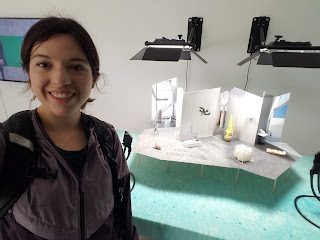Event Blog 1: Acoustical Visions
 |
| Photo with Bill Fontana |
In his work, Bill uses a seismic accelerometer to capture the microvibrations of a given element. From bridges, to bells, to water, and even sculptures that he comes across, Bill readily analyzes various structures and accompanies the recorded sound with images or video. The technology in which Bill utilizes to create this art is actually very reflective of the work that I have come across in my Mechanical Engineering courses. Comparing the seismic accelerometer photo with my lecture notes from my dynamic systems and feedback course, I notice the close relationship between my studies and the work that Bill creates. Thus, I can find greater appreciation for the artist's curiosity and use of a piece of technology that I would have considered solely useful for structural engineering purposes.
 |
| Inner Workings of a Seismic Accelerometer |
 |
| Lecture Notes from MAE 107 (Tsu Chin Tsao) |
I would strongly recommend anyone to explore some of Bill's work. Especially if you are within the fields of mechanical or civil engineering, I am sure that you would find great appreciation in experiencing technology in this creative way. A pattern I noticed among Bill's music sculptures was that most of the recordings came off as eerie and echo-y, which truly grips the attention of the listener because it's not what one would expect from the subjects. Bill mentioned that some people have asked him why he tries to listen to the sound of silence. I believe that there is indeed something powerful about Bill's work. It shows that despite the distracting business of everyday life, there are always opportunities to slow down, listen more, and discover amazing things if only we would take the time to do so. There is so much we have yet to appreciate about the world around us. Artistic use of technology then becomes a significant means in which to remind us of these truths.
 |
| My Favorite Sound Image (Fontana) |
 |
| Bridge Sounds |
Sources
Bux. “Bill Fontana – Harmonic Bridge.” Sound Art Zone, Sound Art Zone, 5 Feb. 2016, www.soundart.zone/2016/02/05/bill-fontana-harmonic-bridge/.
ResearchGate, 7 Apr. 2018, www.researchgate.net/figure/A-typical-deflection-type-seismic-accelerometer-In-this-basic-accelerometer-the-seismic_fig1_229754478.
“The Sound Sculptures, Acoustical Visions and Ideas of Bill Fontana.” Bill Fontana Sound Sculptures, www.resoundings.org/.
Tsao, Tsu Chin. “Mechanical and Aerospace Engineering Systems and Feedback Lecture Series.” 18 Oct. 2017, UCLA, UCLA.
ResearchGate, 7 Apr. 2018, www.researchgate.net/figure/A-typical-deflection-type-seismic-accelerometer-In-this-basic-accelerometer-the-seismic_fig1_229754478.
“The Sound Sculptures, Acoustical Visions and Ideas of Bill Fontana.” Bill Fontana Sound Sculptures, www.resoundings.org/.
Tsao, Tsu Chin. “Mechanical and Aerospace Engineering Systems and Feedback Lecture Series.” 18 Oct. 2017, UCLA, UCLA.


Comments
Post a Comment